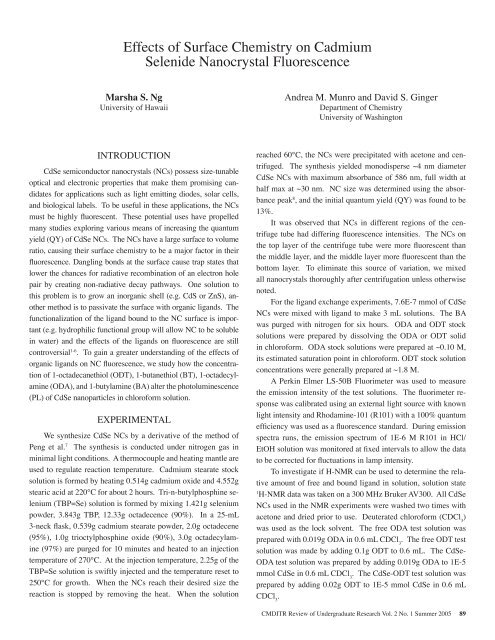Student Project Abstracts 2005 - Pluto - University of Washington
Student Project Abstracts 2005 - Pluto - University of Washington
Student Project Abstracts 2005 - Pluto - University of Washington
You also want an ePaper? Increase the reach of your titles
YUMPU automatically turns print PDFs into web optimized ePapers that Google loves.
Effects <strong>of</strong> Surface Chemistry on CadmiumSelenide Nanocrystal FluorescenceMarsha S. Ng<strong>University</strong> <strong>of</strong> HawaiiAndrea M. Munro and David S. GingerDepartment <strong>of</strong> Chemistry<strong>University</strong> <strong>of</strong> <strong>Washington</strong>INTRODUCTIONCdSe semiconductor nanocrystals (NCs) possess size-tunableoptical and electronic properties that make them promising candidatesfor applications such as light emitting diodes, solar cells,and biological labels. To be useful in these applications, the NCsmust be highly fluorescent. These potential uses have propelledmany studies exploring various means <strong>of</strong> increasing the quantumyield (QY) <strong>of</strong> CdSe NCs. The NCs have a large surface to volumeratio, causing their surface chemistry to be a major factor in theirfluorescence. Dangling bonds at the surface cause trap states thatlower the chances for radiative recombination <strong>of</strong> an electron holepair by creating non-radiative decay pathways. One solution tothis problem is to grow an inorganic shell (e.g. CdS or ZnS), anothermethod is to passivate the surface with organic ligands. Thefunctionalization <strong>of</strong> the ligand bound to the NC surface is important(e.g. hydrophilic functional group will allow NC to be solublein water) and the effects <strong>of</strong> the ligands on fluorescence are stillcontroversial 1-6 . To gain a greater understanding <strong>of</strong> the effects <strong>of</strong>organic ligands on NC fluorescence, we study how the concentration<strong>of</strong> 1-octadecanethiol (ODT), 1-butanethiol (BT), 1-octadecylamine(ODA), and 1-butylamine (BA) alter the photoluminescence(PL) <strong>of</strong> CdSe nanoparticles in chlor<strong>of</strong>orm solution.EXPERIMENTALWe synthesize CdSe NCs by a derivative <strong>of</strong> the method <strong>of</strong>Peng et al. 7 The synthesis is conducted under nitrogen gas inminimal light conditions. A thermocouple and heating mantle areused to regulate reaction temperature. Cadmium stearate stocksolution is formed by heating 0.514g cadmium oxide and 4.552gstearic acid at 220°C for about 2 hours. Tri-n-butylphosphine selenium(TBP=Se) solution is formed by mixing 1.421g seleniumpowder, 3.843g TBP, 12.33g octadecence (90%). In a 25-mL3-neck flask, 0.539g cadmium stearate powder, 2.0g octadecene(95%), 1.0g trioctylphosphine oxide (90%), 3.0g octadecylamine(97%) are purged for 10 minutes and heated to an injectiontemperature <strong>of</strong> 270°C. At the injection temperature, 2.25g <strong>of</strong> theTBP=Se solution is swiftly injected and the temperature reset to250°C for growth. When the NCs reach their desired size thereaction is stopped by removing the heat. When the solutionreached 60°C, the NCs were precipitated with acetone and centrifuged.The synthesis yielded monodisperse ~4 nm diameterCdSe NCs with maximum absorbance <strong>of</strong> 586 nm, full width athalf max at ~30 nm. NC size was determined using the absorbancepeak 8 , and the initial quantum yield (QY) was found to be13%.It was observed that NCs in different regions <strong>of</strong> the centrifugetube had differing fluorescence intensities. The NCs onthe top layer <strong>of</strong> the centrifuge tube were more fluorescent thanthe middle layer, and the middle layer more fluorescent than thebottom layer. To eliminate this source <strong>of</strong> variation, we mixedall nanocrystals thoroughly after centrifugation unless otherwisenoted.For the ligand exchange experiments, 7.6E-7 mmol <strong>of</strong> CdSeNCs were mixed with ligand to make 3 mL solutions. The BAwas purged with nitrogen for six hours. ODA and ODT stocksolutions were prepared by dissolving the ODA or ODT solidin chlor<strong>of</strong>orm. ODA stock solutions were prepared at ~0.10 M,its estimated saturation point in chlor<strong>of</strong>orm. ODT stock solutionconcentrations were generally prepared at ~1.8 M.A Perkin Elmer LS-50B Fluorimeter was used to measurethe emission intensity <strong>of</strong> the test solutions. The fluorimeter responsewas calibrated using an external light source with knownlight intensity and Rhodamine-101 (R101) with a 100% quantumefficiency was used as a fluorescence standard. During emissionspectra runs, the emission spectrum <strong>of</strong> 1E-6 M R101 in HCl/EtOH solution was monitored at fixed intervals to allow the datato be corrected for fluctuations in lamp intensity.To investigate if H-NMR can be used to determine the relativeamount <strong>of</strong> free and bound ligand in solution, solution state1H-NMR data was taken on a 300 MHz Bruker AV300. All CdSeNCs used in the NMR experiments were washed two times withacetone and dried prior to use. Deuterated chlor<strong>of</strong>orm (CDCl 3)was used as the lock solvent. The free ODA test solution wasprepared with 0.019g ODA in 0.6 mL CDCl 3. The free ODT testsolution was made by adding 0.1g ODT to 0.6 mL. The CdSe-ODA test solution was prepared by adding 0.019g ODA to 1E-5mmol CdSe in 0.6 mL CDCl 3. The CdSe-ODT test solution wasprepared by adding 0.02g ODT to 1E-5 mmol CdSe in 0.6 mLCDCl 3.CMDITR Review <strong>of</strong> Undergraduate Research Vol. 2 No. 1 Summer <strong>2005</strong> 89




